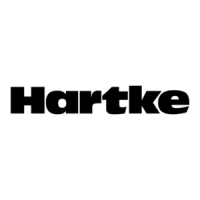13
Using Equalization and Shape
The Hartke Systems HA3000 and HA4000 Bass Amplifiers give you enormous control
over shaping the sound of your bass, using a process called equalization. To understand
how this works, it’s important to know that every naturally occurring sound consists of a
broad range of pitches, or
frequencies, combined together in a unique way. This blend is
what gives every sound its distinctive tonal color. The HA3000 / HA4000 EQ controls allow
you to alter a sound by boosting or attenuating specific frequency areas—they operate
much like the bass and treble controls on your hi-fi amp, but with much greater precision.
The HA3000 offers four bands of equalization. Each EQ knob (labeled
Low, Mid Low,
Mid High and High, respectively) affects a different frequency area (80 Hz, 220 Hz, 770 Hz
and 5 kHz, respectively) and provides approximately 15 dB of boost and attenuation.
We carefully selected these frequency areas because they have maximum impact on bass
signals. For example, the Low (80 Hz) control affects the very lowest audible frequencies
(in fact, most humans cannot hear below 20 Hz), while the High (5 kHz) control affects the
“twang” of a bass string.
The HA4000 also provides four bands of equalization, plus a special “DBASS” (for “Deep
Bass”) band, which adds ultra-low subharmonic frequencies to the sound. As you move its
knob clockwise, more and more of this signal is added (up to 12 dB). The
Low and High
EQ knobs affect the frequency areas of 140 Hz and 5 kHz, respectively. However, the two
mid bands—Mid Low and Mid High—are fully parametric, which means that you can not
only choose the frequency you want affected (between 40 Hz and 400 Hz in the case of
Mid Low, and between 300 Hz and 6 kHz in the case of Mid High), but you can also set
something called
bandwidth for each frequency area. As you turn the Bandwidth knob
clockwise, the width of the equalization curve is narrowed and only a small frequency
range is affected; as it is turned counterclockwise, the width of the equalization curve is
expanded and a greater frequency range is affected. Narrower bandwidths give you finer
equalization control, while wider bandwidths give you broader control—kind of like a painter
choosing between a fine brush or a wide brush. As with the HA3000, all four bands of
equalization can be boosted or attenuated by approximately 15 dB.

